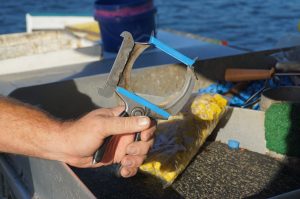Fishing and de Quervain’s Tenosynovitis
Morgan Becker, B.S., OT/S
Johnson & Wales University
Occupational Therapy Entry-Level Doctorate
 Have you ever been pulling in a lobster trap and experienced pain or swelling at the base of your thumb? Maybe even coupled with a “sticking” sensation when you move your thumb and wrist? Well, those symptoms might be caused by De Quervain’s Tenosynovitis (DQT).
Have you ever been pulling in a lobster trap and experienced pain or swelling at the base of your thumb? Maybe even coupled with a “sticking” sensation when you move your thumb and wrist? Well, those symptoms might be caused by De Quervain’s Tenosynovitis (DQT).
DQT is a repetitive-use injury of the wrist and thumb that causes a tendon in the wrist to become trapped. Once this tendon becomes entrapped, performing everyday work tasks such as pulling in traps, banding lobster claws, squeezing pliers, mending nets, or any task involving the thumb and surrounding wrist area become painful and potentially unbearable. Aggravation of this tendon at work, may also lead to lingering affects at home when doing similar movements during household chores or caring for children.
If this description is relatable to you, there is a simple test that can be performed to help indicate the presence of DQT. It is called the Finkelstein’s test. To perform this, simply close your fist around your thumb, orient your fist so your thumb knuckle is pointed up, and then extend your fist toward the floor. If the motion causes a painful feeling in the wrist below the thumb, this could mean DQT. This information is not meant to self-diagnose, rather to provide you with more information to have clear communication with your primary care physician (PCP).
If you or someone you work with is experiencing signs of DQT, don’t wait to get evaluated; prolonging treatment may lead to surgery and a longer road to recovery. Schedule an appointment with your PCP as soon as symptoms appear to avoid losing function in your thumb completely.
Common treatments for DQT include taking anti-inflammatories, receiving corticosteroid injections, and splinting with a thumb spica brace. (Although the brace must be worn consistently in order to be effective.) In severe cases, surgery to release the trapped tendon is the only option. Recovery is typically two weeks of minimal usage, and the stitches are removed at the end of this period. After the initial recovery period, it is normal to experience swelling and tenderness at the site of the surgery for a few months.
Now to tackle fishing with DQT; it’s your career and you shouldn’t have to change paths. In any task where pain occurs, stop the movement, and check to make sure you have your wrist in its natural position (not twisted or turned at any awkward angle). In addition, adaptive equipment and adaptive techniques can support you on the job. Equipment such as using wristbands to ease the load on yourself, a thumb spica brace during painful tasks, and making handles on pliers, levers, and other tools larger to allow for easier grip. Other options could be adaptive techniques. Instead of mending your own nets, delegate someone to help with this task and focus on another task that doesn’t irritate the affected area. If you have been diagnosed with DQT and are still having trouble on the job, ask your PCP about a referral to occupational therapy to help you obtain adaptive equipment and perform your best at your job and at home.
As an additional resource, contact Maine FishAbility for more information on adaptive equipment for your job, at 207.944.1533.
